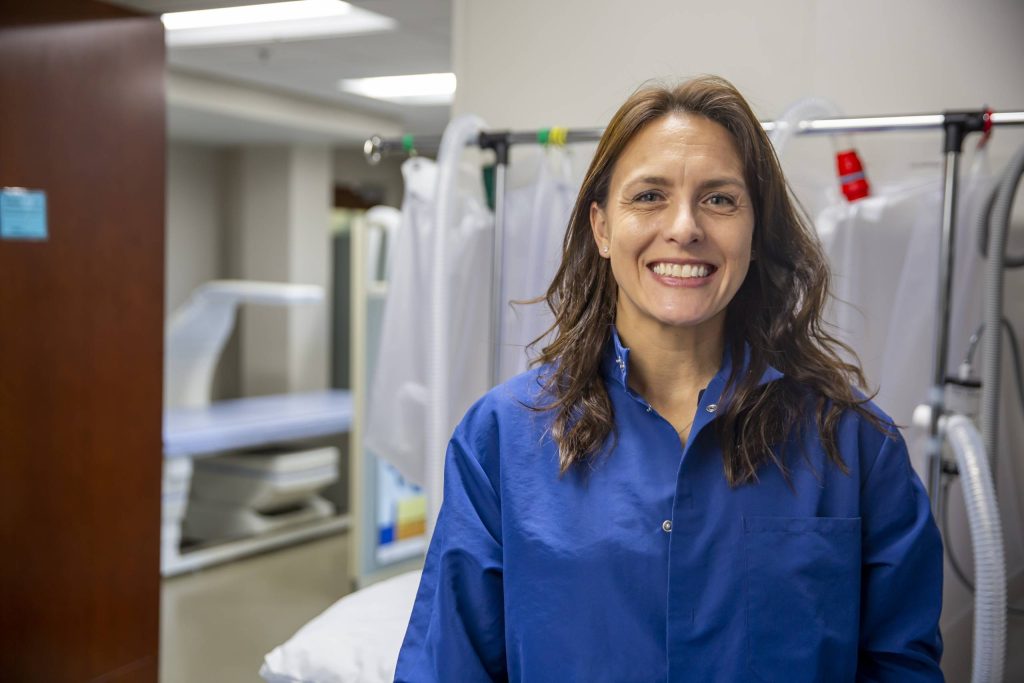
What do little girls dreaming of being an astronaut and women with sleep apnea have in common? They may both benefit from the research of Jackie Limberg, assistant professor in nutrition and physiology.
When Limberg and her team of graduate students were examining the effects of hypoxia — low oxygen — and the body’s response, they found that women and men were affected differently, and they had good reason to take a deeper dive into that realization.
“It’s not that it was really shocking what we found,” she said. “It was shocking that it hadn’t been studied before.”
Until now, that is. Limberg and her graduate students, Dain Jacob, with funding from the National Institute of Health and the American Heart Association, are working to bridge that gap. Over the years, her research has become very focused on women’s health.
When the body is exposed to low oxygen, it can cause a number of other reactions including changes in blood pressure and impaired cognition. Limberg wants to know if these effects might be worse in women —a group often excluded from this type of research.
One reason these studies may have been neglected in the past is simple logistics. Limberg explained that the resources she has at the University of Missouri place her in a prime position to do the research she does.
“I couldn’t do this work anywhere else,” Limberg said. “It’s not just the kind of researchers we have, but that they are so willing to collaborate.”
Limberg relies on the help of two cardiologists with the MU School of Medicine, Brian Bostick and Arun Kumar. She explained that Bostick and Kumar act as clinician scientists and are essential to the research team. They volunteer their time administering medications, inserting catheters and performing other clinical tasks with study participants. She said that this level of collaboration across colleges is often unheard of at other universities.
This collaboration is essential for her other research focus as well. Limberg is also highly interested in the effects of insulin on the brain and nervous system. Specifically, Limberg said that she is interested to see the effects on blood pressure and blood flow throughout the body, which are both controlled by the nervous system.
This project is highly collaborative with other researchers in the university as Limberg discovered she is not the only person who was studying the effects of insulin on blood flow.
“This has been a fun project because we ask the same question from different angles,” she said. “One group is interested in how insulin makes blood flow go up. I am interested in how it makes it go down.”
Limberg’s faculty collaborators on this project are fellow nutrition and exercise physiology associate professor Jaume Padilla and associate professor of medicine and board-certified endocrinologist, Camila Manrique. Padilla and Manrique both call NextGen Precision Health their home, while Limberg is based in CAFNR.
Additionally, in pursuit of an interest of one of her PhD students, Brian Shariffi, Limberg and Padilla are currently using a CAFNR Joy of Discovery seed grant to explore potential links between insulin, blood flow, and cognition. She is hoping to be able to expand that project with additional external funding in the future.
When Limberg isn’t working on research, she is teaching both undergraduate and graduate students, and said she believes that training the next generation of scientists and clinicians is a vital part of her role.
In fact, her undergraduate students occupied both the first and second place positions of the undergraduate poster competition at the CAFNR Research Symposium earlier this year.
“It was neat to see them say, ‘yeah, a poster or a lightening talk might be a good challenge for me,’” Limberg said. “It was so good to see that kind of motivation.”
It is a motivation Limberg knows well as her own desire to be a physiology researcher goes back to her own undergraduate education.
As a collegiate rugby player, exercise physiology was a natural fit for Limberg.
“It was very accessible to me because I could apply it to what I was doing in training with my own body,” she said.
She was fortunate to be selected to work on some research projects as an undergraduate, and that is when it clicked that this was how she wanted to spend her time going forward.
“I got to work with patients, and I got to look at what was going on in their bodies, and I thought, ‘This is a job that I get to do?’” she said. “I realized that I could work with patients not as a clinician, but as a researcher.”
Limberg continues to stress that it is the collaborative nature of MU that really continues to fuel her work. In addition to interdisciplinary faculty, this includes the rotation of undergraduate researchers whose focus is on other areas within the life sciences and her lab manager, Jennifer Harper, who is a crucial part of her work.
“She is incredible,” Limberg said of Harper. “If I hadn’t hired her, I wouldn’t be able to do what I do. She just removes so many barriers.”